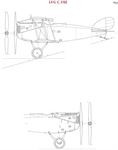
| Самолеты (сортировка по:) | |||||
| Страна | Конструктор | Название | Год | Фото | Текст |
LVG C.VIII

|
Страна: Германия Год: 1918
|
| LVG - C.VI - 1918 - Германия | <– | –> | LVG - D.V/D.VI - 1918 - Германия |
 |
J.Herris - LVG Aircraft of WWI. Volume 3: Types C.VI-C.XI & Fighters /Centennial Perspective/ (36) |
| The LVG C.VIII prototype photographed at Johannisthal on 30 August 1918. This handsome two-seater was powered by a 240 hp Benz Bz.IVu high altitude engine. (Peter M. Grosz Collection/SDTB) |
 |
J.Herris - Development of German Warplanes in WWI /Centennial Perspective/ (1) |
| The handsome LVG C.VIII with frontal radiator was the next development of the LVG C-types. Powered by the 230 hp Benz Bz.IVa, it was too late to arrive at the front before the armistice. The LVG C.VIII was designed for the high-compression 200hp Benz I (to give 240hp) for altitude performance. In the event, however, the prototype was a one-off as production effort was concentrated on more promising types. |
 |
J.Herris - LVG Aircraft of WWI. Volume 3: Types C.VI-C.XI & Fighters /Centennial Perspective/ (36) |
| The LVG C.VIII prototype photographed at Johannisthal; the bottom photo was taken on 30 August 1918 and it is likely the others were also. The nose radiator is the most distinctive feature that differentiates the C.VIII from its C.VI predecessor, followed by the ailerons on all wings connected by actuating struts. The 240 hp Benz Bz.IVu high altitude engine was a development of the 220 hp Benz Bz.IVa used in the LVG C.VI. (Peter M. Grosz Collection/SDTB) |
 |
J.Herris - LVG Aircraft of WWI. Volume 3: Types C.VI-C.XI & Fighters /Centennial Perspective/ (36) |
| The LVG C.VIII prototype photographed at Johannisthal. (Peter M. Grosz Collection/SDTB) |
 |
J.Herris - LVG Aircraft of WWI. Volume 3: Types C.VI-C.XI & Fighters /Centennial Perspective/ (36) |
| The LVG C.VIII prototype photographed at Johannisthal with some members of the test and development team. (Peter M. Grosz Collection/SDTB) |
 |
J.Herris - LVG Aircraft of WWI. Volume 3: Types C.VI-C.XI & Fighters /Centennial Perspective/ (36) |
| The LVG C.VIII prototype photographed at Johannisthal post-war as indicated by the large "L.V.G." painted underneath each lower wing. (Peter M. Grosz Collection/SDTB) |
 |
J.Herris - LVG Aircraft of WWI. Volume 3: Types C.VI-C.XI & Fighters /Centennial Perspective/ (36) |
| LVG C.VIII |
 |
J.Herris - LVG Aircraft of WWI. Volume 3: Types C.VI-C.XI & Fighters /Centennial Perspective/ (36) |
| LVG C.VIII |
 |
J.Herris - LVG Aircraft of WWI. Volume 3: Types C.VI-C.XI & Fighters /Centennial Perspective/ (36) |
| LVG C.VIII |
 |
J.Herris - LVG Aircraft of WWI. Volume 3: Types C.VI-C.XI & Fighters /Centennial Perspective/ (36) |
| LVG C.VIII |